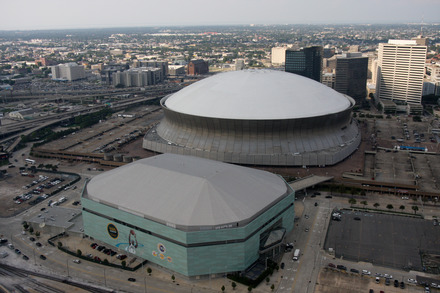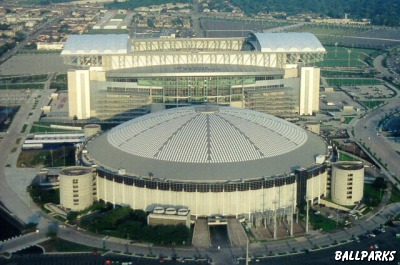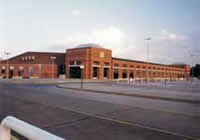
Over five and a half years ago, the nation saw firsthand just how great it is to have sports venues around during a natural disaster.
On August 29th, 2005, Hurricane Katrina struck New Orleans killing 1,836 people while causing $81.2 billion in damages.
As most of you who remember Hurricane Katrina know, there was literally only one venue that was capable of providing relief to 1,000s of hurricane victims. That venue was the Louisiana Superdome.
Opened in 1975, the Louisiana Superdome (which also happens to be run by SMG as well) is the largest fixed domed structure in the world. Its steel frame covers a 13-acre expanse. Its 273-foot dome is made of a Lamella multi-ringed frame and has a diameter of 680 feet (wikipedia). It's main tenant is the NFL's New Orleans Hornets.
Over the course of time, the Superdome has seen many great events including 3 BCS championship games, 6 Super Bowls, 4 NCAA men's basketball championships, and over 33 Sugar Bowl games. However, none of those events would push the Superdome to the brink like Hurricane Katrina.
During the whole Hurricane Katrina disaster, over 35,000 people came to the Superdome as a "shelter of last resort."
Hurricane Katrina landed several punches on the Superdome. All-in-all, the hurricane caused over $185 million in damages to the dome. Most of the Superdome's damage occured on its roof where hurricane victims reportedly saw 2 large holes big enough to bring daylight inside the facility.

http://en.wikipedia.org/wiki/Effect_of_Hurricane_Katrina_on_the_Louisiana_Superdome
However, the damage to the roof was not catastrophic, with just two relatively small holes and the ripping off of most of the easily replaceable white rubber membrane on the outer layer.
That is the important thing to remember, the Superdome held. Many people thought it was going to have to be demolished (http://www.fanblogs.com/ncaa/005638.php) but that wasn't the case. The Superdome still stands today and is undergoing a $30 million renovation. Without the Louisiana Superdome, Hurricane Katrina would have been even worse than it was. There's no doubt that the Superdome saved many lives.
There were other sports venues that played an important role in Hurricane Katrina as well.
New Orleans Arena

Following Hurricane Katrina on August 29, 2005, medical operations that had previously been housed in the Superdome were moved to the Arena. Medical personnel had been working in an area of the Superdome with poor lighting, leaking ceilings and soggy carpet. The Arena's design was tested in 1996 by CPP, a wind engineering consulting firm, so it fared far better than the Superdome during the storm and was in better condition to house sensitive medical operations (wikipedia). New Orleans Arena also happens to be run by SMG who manages our Roberts Stadium.
The Houston Astrodome

On August 31, 2005, in the wake of Hurricane Katrina, the Harris County Department of Homeland Security and Emergency Management and the State of Louisiana came to an agreement to allow at least 25,000 refugees from New Orleans, especially those that were sheltered in the Louisiana Superdome, to move to the Astrodome until they could return home. The evacuation began on September 1 (wikipedia).
For those of you still thinking, " Yea that's great but a hurricane can't happen here, and I seriously doubt a natural disaster will ever hit the Tri-State," think again.
Yes, hurricanes are not a threat to the Tri-State but when it comes to natural disasters it is pick your poison. Here in the Tri-State, storms, tornadoes, earthquakes, and floods not to mention terrorism all pose a serious threat.
For those of you who have stayed up late at night this week waiting for the storm sirens to go off, you realize just how realistic a natural disaster is here. In fact, the Tri-State has seen several tornadoes and "catastrophic" flooding just this week. As I speak, there are still several local residents without power or without a home because it is under water.
Mr. Larry Caplan talked about the local disasters and how to be prepared in the Courier & Press about a month ago...
http://www.courierpress.com/news/2011/mar/20/proper-preparation-can-aid-survival-during/
Besides the usual tornadoes and flooding, there will always linger the New Madrid Fault Line which is capable of a massive earthquake at any time...
http://en.wikipedia.org/wiki/New_Madrid_Fault_Line
The biggest quake since 1811-1812 was a 6.6-magnitude quake on October 31, 1895, with an epicenter at Charleston, Missouri. The quake damaged virtually all buildings in Charleston, creating sand volcanoes by the city, cracked a pier on the Cairo Rail Bridge and toppled chimneys in St. Louis, Missouri, Memphis, Tennessee, Gadsden, Alabama and Evansville, Indiana.
The next biggest quake was a 5.4-magnitude quake (although it was reported as a 5.5 at the time) on November 9, 1968, near Dale, Illinois. The quake damaged the civic building at Henderson, Kentucky and was felt in 23 states. People in Boston said their building swayed. It is the biggest recorded quake with an epicenter in Illinois in that state's recorded history.
In a report filed in November 2008, The U.S. Federal Emergency Management Agency warned that a serious earthquake in the New Madrid Seismic Zone could result in "the highest economic losses due to a natural disaster in the United States," further predicting "widespread and catastrophic" damage across Alabama, Arkansas, Illinois, Indiana, Kansas, Kentucky, Mississippi, Missouri, Oklahoma, Texas, and particularly Tennessee, where a 7.7 magnitude quake or greater would cause damage to tens of thousands of structures affecting water distribution, transportation systems, and other vital infrastructure. The earthquake is expected to also result in many thousands of fatalities, with more than 4,000 of the fatalities expected in Memphis alone.
You ever wonder why Ellis Park is on the Indiana side of the river instead of the Kentucky side? It's because the New Madrid earthquake of 1812 moved the Ohio River to the south of Ellis Park. Before 1812, the land Ellis Park sits on was actually on the Kentucky side.
And then there's the Wabash Valley Fault Line...
http://en.wikipedia.org/wiki/Wabash_Valley_Seismic_Zone
It's only been 3 years since this fault line struck the Evansville area.
So with all of that being said, we clearly need facilities large enough to hold disaster victims.
Sure the new arena is capable of doing that and even the Centre and C.K Newsome Center could hold a few thousand people as well. There's also the Sportscenter in Owensboro. However, those facilities will not be enough to hold a fair amount of residents in the Tri-State.
With over 900,000 people in the 30-county region of the Tri-State, we need enough facilities to be able to hold at least 10% of that minimally.
The only indoor building capable of complimenting the new arena with ample amount of square footage is Roberts Stadium.
Roberts Stadium has 2 meeting rooms, a 144' x 100' floor, and 3 truck docks with housing for up to 6 buses as well as the 4,000 car parking lot where other FEMA trailers can be parked. Roberts Stadium also has full A/V services and internet access.
Why would anyone want to demolish a facility that is complete with all the necessities for a disaster mobilization center? If city hall wants to demolish Roberts Stadium, they need to give a pretty good reason for why they are abandoning a facility that has plenty of space to house thousands of victims, 2 meeting rooms to coordinate disaster relief operations with internet access to communicate commands, a loading dock and staging area capable of bringing in and parking up to 6 buses with nearby disaster victims, and a parking lot large enough to stage FEMA buses, trailers, and other relief vehicles.
In August of 2005, the city of New Orleans used the Louisiana Superdome and New Orleans Arena in the city's darkest hours. Shouldn't we do the same with the new arena and Roberts Stadium?
Email the mayor, the Courier and Press, and both the Evansville City Council and Vanderburgh County Council. Tell them to stop messing around with the Tri-State's safety, SAVE ROBERTS STADIUM!

No comments:
Post a Comment